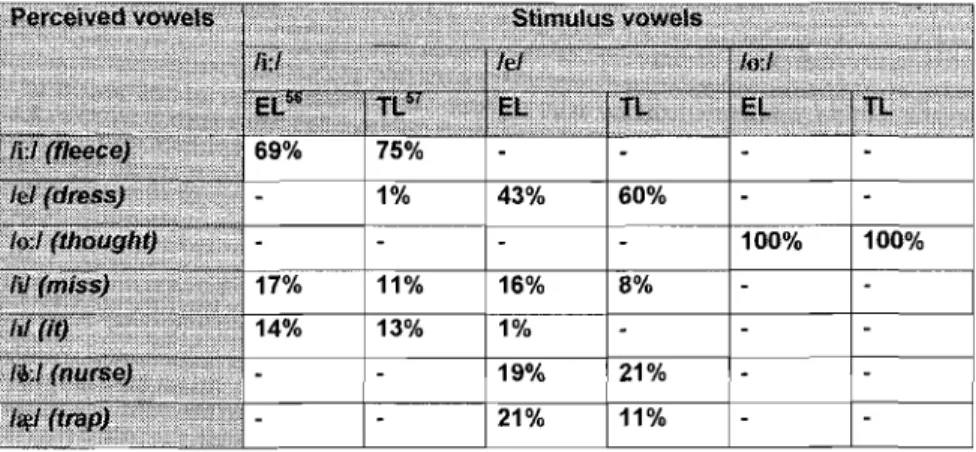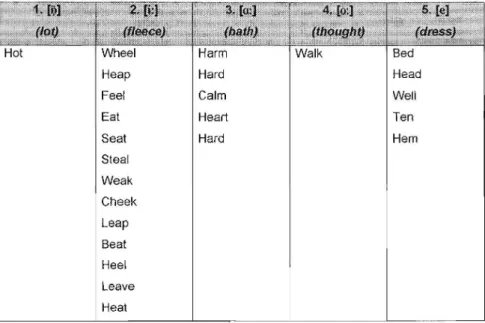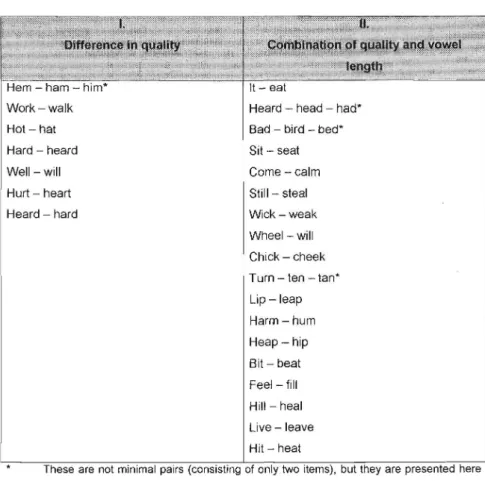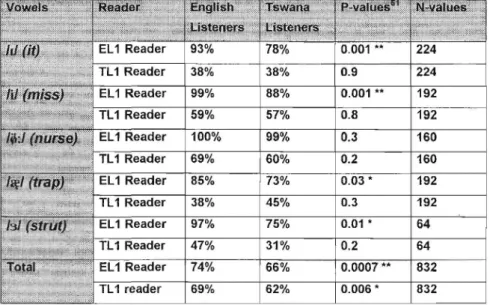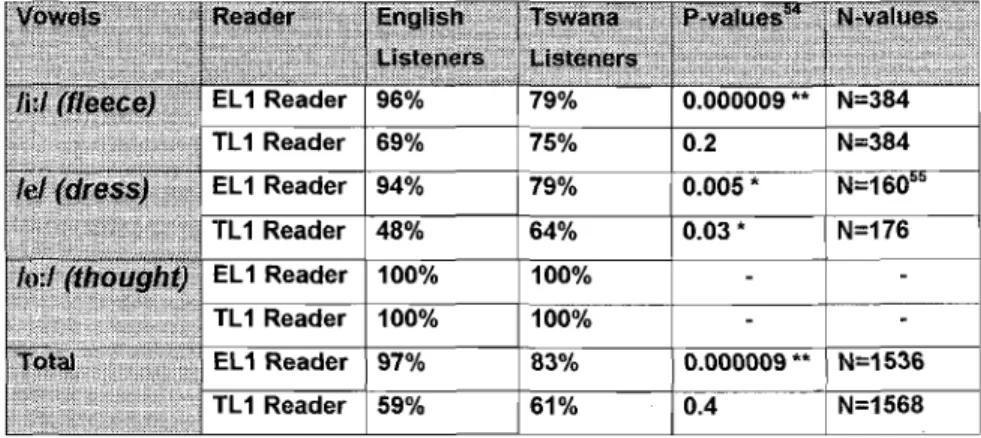Dissertation submitted in fulfillment of the requirements for the degree of Magister Artium in Applied Language Studies Potchefstroomse Universiteit source. Without the help and support of the following persons and institutions, the completion of this study would not have been possible.
INTRODUCTION
GENERAL OBSERVATIONS
PROBLEM STATEMENT
Flege, on the other hand, argues that L2 phones unknown in L1 are pronounced more accurately than phones similar to those of the L1 (see Flege & Hillenbrand, 1984; Flege, 1987). To what extent do differences in vowel pronunciation affect the intelligibility of TE.
Objectives
Basic hypothesis
Because the vowel systems of Tswana and Nguni (as used by Glaser, 1995) are similar, the results of this study can be expected to be quite similar to those of Glaser.
Outline of the study
Chapter 5 presents the conclusion of this study, as well as recommendations for further investigation and research in light of answers not provided in the present study. Depending on how quickly socio-cultural bams follow the collapse of political bams in South Africa, there will be further mixing of dialects and languages in that country (Sarinjeive.
Introduction
Theoretical background
- Intelligibility
- Language transfer
- Interlanguage
- The Similarity Differential Rate Hypothesis
The Equity Differential Rate Hypothesis, as proposed by Major and Kim (1996), is a development of the IL concept discussed earlier. After these differences are identified, an attempt will be made to explain these differences in light of the above theories.
The vowel system of Tswana
- Linguistic classification
- The vowels
- Vowel raising (partial height assimilation)
The standardized written form of Tswana is based on closely related core dialects because they are geographically central and show the least evidence of influence from other Bantu languages (see Cole, 1955:xix). In his study of the phonology of the Central, Eastern and Southern Tswane dialects, Malepe states that one vowel system applies to all Tswane dialects. Dialects in which pronunciation differences occur merely substitute one vowel in the system for another, but are never a vowel.
19 Kan nama ajaa’ibu, loqoda Sekomaa fi - hamma tokko - Sekenye Kgalagadi keessatti, dubbachiiftoonni bu’uuraa Kgalagadi torba ni mul’atu (kanneen Tswana wajjin walsimu), garuu bifa hidhiitiin (Kruger &. ilaali Kgalagadi kan Pretorius, Roux fi Wissing ( 1998) ti ) Id yeroo tokko tokko bifa null gocha hortative, subjunctive fi imperative tiin gara HItti akka ol ka’u argataniiru.
The discussion now turns to the vowel system of English, to compare it with that of Tswana.
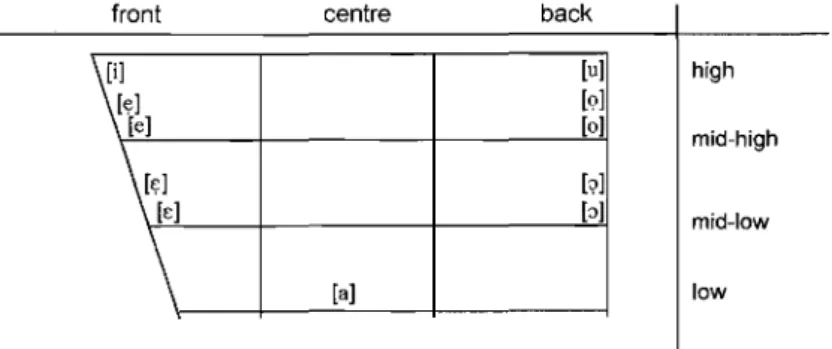
The vowel system of English
- The diversity in the SAE community
However, South African English pronunciation does not meet all the standards of RP, and North West Province English can be expected to do so much less. Clearly, the English generally spoken in the areas where Tswana speakers live cannot be a variety that conforms to RP standards. Of the above accents of SAE, Cons SAE does not seem to be an appropriate standard for the English generally spoken26 in the Tswana-speaking area.
Ext SAE also seems inappropriate, as the standard of English pronunciation in this field is unlikely to be set by the lower class sector of African descent, especially not in the media. However, Resp SAE seems the most likely SAE standard spoken in the Tswana-speaking area, because "it is less visible as a differentiation between social groups". Lanham & MacDonald and is not marked regionally in the same way as Ext SAE of the Eastern Cape, for example.
For this reason, Resp SAE will be used in this thesis as the standard for SAE in the Tswana-speaking area.
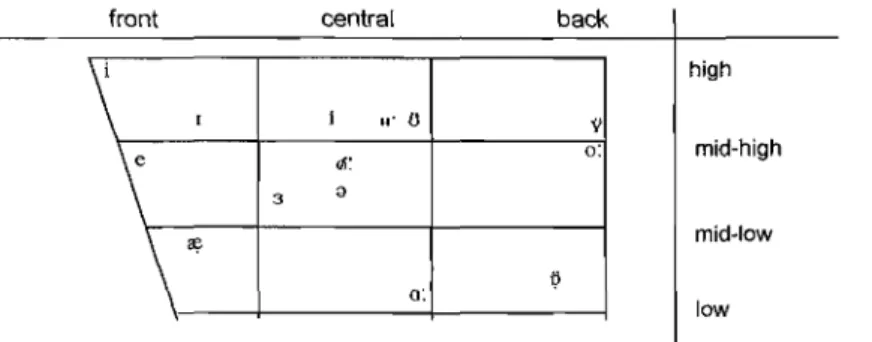
The vowel systems of Tswana and Resp SAE compared
Of the 14 Resp SAE primary vowels, only three occur in the sound system of Tswana. It is highly likely that they will be produced quite accurately in the English of a Tswana speaker. There are four vowels in the sound system of Tswana that do not occur in Resp SAE.
It is possible that some of these vowels are used when they approximate vowels in the English phonetic system, but this theory remains to be proven by empirical research. The remaining 10 vowels of Resp SAE do not appear in the Tswana sound system. The vowel /y/ as an allophone of the vowel IM KIT (see Lass) will not be considered separately, but will be included in the minimal pairs of IM.
Although it could probably be confused with hi in Tswana speech (e.g. cot: caught, rot: broken), minimal pairs containing these vowels were not included in the perception tests.
Summary
From the above it is clear that vowel length in Tswana occurs regularly in specific syntactic circumstances and does not serve as a means of distinguishing word pairs, i.e., this is probably why Tswana speakers have difficulty distinguishing between long vowels and short. Dreyer, Wissing and Wissing (1996:52) found in their study of the relationship between cognitive styles and pronunciation accuracy that "the Tswana-speaking group, all cognitive styles considered, were unable to distinguish between vowel lengths ".
The results obtained are expected to be similar to those of Glaser's (1995) study of Nguni vowels. In Chapter 3, the design of the empirical research, as well as its results and statistical analysis, will be presented.
EMPIRICAL RESEARCH
Introduction
The study design is presented, the selection of subjects and stimulus groups is explained, and the instruments and data processing tools are reported.
Design
Procedure
- Subjects
- Instrumentation
- Language background questionnaire
TL1: Potchefstroom Boys' Secondary School eighth graders who attended a primary school in the North-West Province and speak Tswana at home38. The subject groups selected in this way are samples of availability and cannot necessarily be considered representative of the Tswana speakers of the North West Province. The subjects were selected from the only English medium school in Potchefstroom, where this study was conducted.
Each speaks the given language (Tswana or English) at home and has been a resident of North West Province for the past five years. This was done to prevent a subjective choice on the part of the researcher, in an attempt to select subjects who would "ideally" fit his hypothesis. 38 The ideal would be to have involved boys who attended an English medium primary school.
Although this is not the main focus of the current study, it was done to provide a background for the main part of the research39.
Place of birth 5. Home language
- Stimulus material
- Recording of the stimulus material
- Perception tests
- Processing of data
- Results
- Perception accuracy
- Responses to the individual vowels
34;correct" than that of the SABE speakers (president Nelson Mandela, Mangosuthu Buthelezi and Popo Molefe). 42 Of the two major African language groups spoken in Potchefstroom (where the research was conducted), i.e. For this reason minimal pairs were used in the perception test, as the listeners' responses would be indicative of the possible effect of first language interference on the English of TL1 speakers.
Minimal pairs can be categorized by how the vowels change (in the case of this study). In Chapter 4, these categories will be considered again when offering (a) possible explanation(s) for the results of the empirical research. The perceptual accuracy of different groups of listeners for different readers is shown in Table 4 below.
In Table 6-7, the perception of the vowels l\l (as in den), lit (as in miss), lil>:l (as in nurse), /as/ (as in trap) and hi (as in strut) is presented in relation to the percentage of accurate perception.
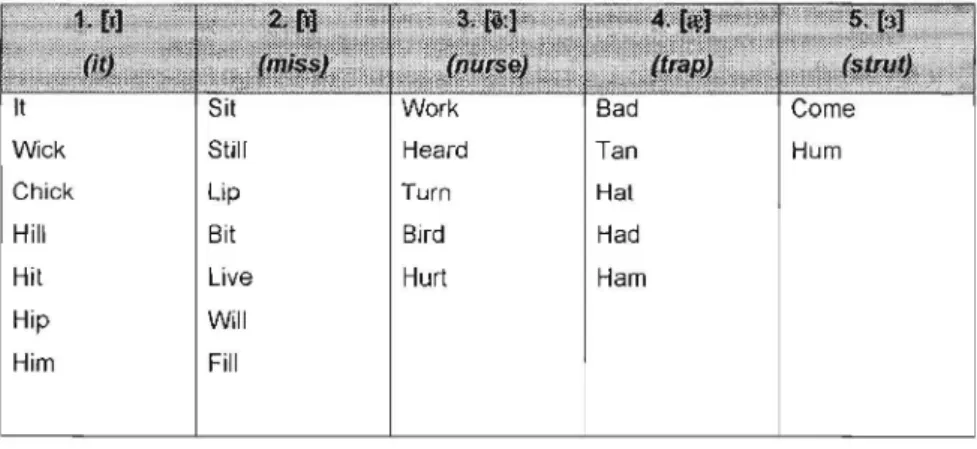
The English reader's vowels were identified more accurately (91%) than the Tswana reader's (47%). From the above-mentioned observations, the following tendencies regarding "new" vowels are evident: (a) EL1 listeners identified vowels more correctly than TL1 listeners in all cases; (b) reader EL1's vowels were perceived more accurately than reader TL1's; (c) Reader TL1's vowels were detected incorrectly more times than they were detected correctly. Each of the individual vowels was perceived as a vowel type by different listeners.
Table 6 shows the detection of individual vowels as read by the TL1 reader. The results are presented according to how the stimulus vowels were perceived, i.e. different responses to stimulus vowels are shown. The vowel hi was also perceived as long /a:/ in most responses.
The percentage of correct perception of the "similar" vowels I'v.l (as in fleece), Id (as in dress) and lo-.l (as in tank) is shown in Table 8 below.
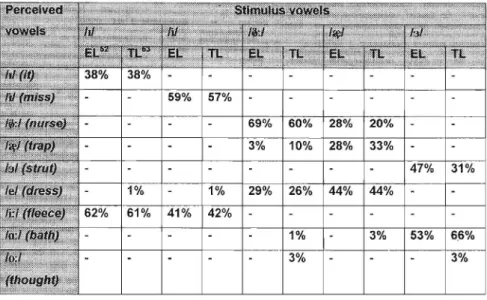
- Conclusion
- Introduction
- Explanation of the data
- Perception accuracy
- Intelligibility of TE vowels
- Summary
- BIBLIOGRAPHY
The results of this study seem to confirm Glaser's, rather than Flege and Hillenbrand's. From the results of the "new" vowels (M, l\l, /#:/, I&I and hi), it is notable that the EL1 listeners perceived the vowels read by the EL1 reader significantly more accurately than the TL1 listeners, whereas difference in perception accuracy in response to the TL1 reader is statistically insignificant. Only the perception of the vowels as read by the TL1 reader is included here, since the focus of the present study is on the TE's vowels.
Each of the "similar" vowels as read by the TL1 speaker will be briefly discussed and possible explanations for the different results will be offered. This hypothesis is also supported by the results of the same vowel as read by speaker EL1. What can be said in the light of the present results is that the vowel change has a severe effect on the intelligibility of TE.
In this chapter, it has been shown that the vowels of the EL1 reader are perceived significantly more accurately than those of the TL1 reader. Research in light of SDRH (see Major & Kim, 1996) may clarify these apparent discrepancies. In chapter 4 it was clearly shown that the vowels of the EL1 reader were perceived significantly more accurately than those of the TL1 reader.
